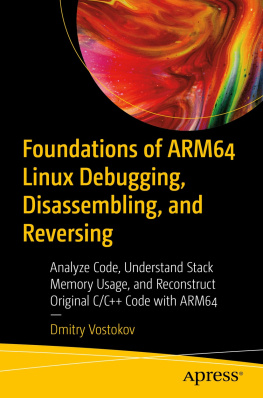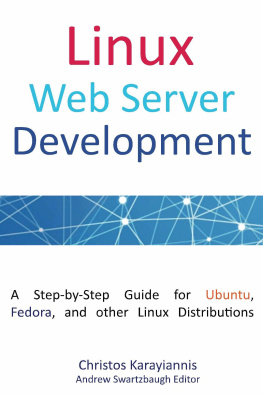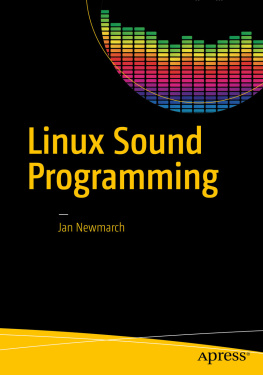Silviu Sosiade - Linux Programming: Building and Debugging
Here you can read online Silviu Sosiade - Linux Programming: Building and Debugging full text of the book (entire story) in english for free. Download pdf and epub, get meaning, cover and reviews about this ebook. year: 2016, genre: Computer. Description of the work, (preface) as well as reviews are available. Best literature library LitArk.com created for fans of good reading and offers a wide selection of genres:
Romance novel
Science fiction
Adventure
Detective
Science
History
Home and family
Prose
Art
Politics
Computer
Non-fiction
Religion
Business
Children
Humor
Choose a favorite category and find really read worthwhile books. Enjoy immersion in the world of imagination, feel the emotions of the characters or learn something new for yourself, make an fascinating discovery.

- Book:Linux Programming: Building and Debugging
- Author:
- Genre:
- Year:2016
- Rating:5 / 5
- Favourites:Add to favourites
- Your mark:
- 100
- 1
- 2
- 3
- 4
- 5
Linux Programming: Building and Debugging: summary, description and annotation
We offer to read an annotation, description, summary or preface (depends on what the author of the book "Linux Programming: Building and Debugging" wrote himself). If you haven't found the necessary information about the book — write in the comments, we will try to find it.
The book covers the following topics:
* building a program, compilation and linking
* overview of GNU C/C++ compiler
* building programs from multiple modules
* make and makefiles
* static and dynamic libraries in Linux
* debugging programs
* detecting memory leaks
The book is addressed to beginners in Linux programming as well as those who have programmed using other environments and operating systems before (Windows, for example) and who now want to learn how to develop programs in Linux.
Linux Programming: Building and Debugging — read online for free the complete book (whole text) full work
Below is the text of the book, divided by pages. System saving the place of the last page read, allows you to conveniently read the book "Linux Programming: Building and Debugging" online for free, without having to search again every time where you left off. Put a bookmark, and you can go to the page where you finished reading at any time.
Font size:
Interval:
Bookmark:
Linux Programming: Buildingand Debuggingby Silviu SosiadeCopyright @ 2016 by Silviu Sosiade. All rights reserved. No part of this publication may be reproduced,distributed or transmitted in any form or by any means, including photocopying,recording or other electronic or mechanical methods, or by any informationstorage retrieval system without the prior written permission of the publisher. Although the author has made every effort to ensure thatthe information in this book was correct at publishing time, the author andpublisher do not assume and hereby disclaim any liability to any party for anyloss, damage, or disruption caused by errors or omissions, whether such errorsor omissions result from negligence, accident, or any other cause.
With the visualinterfaces (KDE , GNOME) that were built specifically for Linux this operatingsystem has become as easy to operate as Windows or MacOS and it is increasinglyperceived less as a operating system for academic or programmers only. Also if you use a setopbox for digital television or if you havean intelligent alarm at home, these devices are likely to use Linux OS as well.That's because Linux operating system has been ported to various types ofprocessors or devices, becoming what we now call "embedded Linux". Although with a very small market share, there are currentlyvariants of mobile phones that use a version of Ubuntu Linux. Whether or notLinux will have a significant market share in the mobile phone market in thefuture, this remains to be seen. But the fact that there are mobile phonesalready using this operating system proves how versatile and flexible solutionLinux has become these days. The first program in Linux was written back in 1991.
This isnearly 25 years ago, which is a considerable age for the software market andand for the IT market in general. In the last 25 years we have seen manysoftware products that had glory days and then replaced by other products. Wehave also seen once renowned companies that are now in the twilight of glory orout of business. Not the same thing happens with Linux. As time passes Linuxbecomes increasingly stronger. The secret of its eternal youth appears to bein using the GNU GPL license, a license that allows anyone to use thisoperating system for free.
Moreover the use of this license has a much widerscope in what free means. This is the freedom to run, copy, distribute,study, change and improve the software. This aspect of freedom is attractinga large number of enthusiasts programmers from all over the world eager tocontribute to the development of Linux. This ultimately creates a synergy hardto replicate for a software system whose code is not visible to the generalpublic and that is developed and maintained only by a company or a group ofcompanies. One thing should be noted here if you do not know this already:Linux is not UNIX. But there is an obvious trend to use these termsinterchangeably.
And that is because there are many common aspects betweenLinux and UNIX, both in terms of usage as well as in term of programming. Notable would also be the fact that there are many similaritiesbetween Android and Linux. Or between Mac OS and Linux. Although there are nocompatibilities at the binary level (the Linux programs can not be executed onMac OS or Android, and vice versa) there are however major similarities interms of operating and programming using these operating systems. And this isunderstandable considering that the development of Android kernel started froman older version of Linux kernel, and various Linux kernel updates happeningnowadays are regularly considered to be imported back into the Android kernel.Also Mac OS started from a variant of UNIX called BSD (Berkeley SoftwareDistribution) that has many similarities with the Linux operating system.Therefore learning Linux opens up larger perspective for the Linux marketitself as well as for other technologies present on the market at the moment. Considering that Linux is gaining more and more ground,programming in Linux is no longer seen as being a niche job anymore.Increasingly more jobs are becoming available and are required for Linuxprogrammers nowadays.
The Linux kernel was initially developed by using the Cprogramming language. Since then, all the development and maintenance has beendone using C. Similarly the majority of libraries and utility programs from adistribution of Linux are also written in C. At the application level, althoughit is possible to use other programming languages (Python , Java , Ruby ...), Cand C++ still remain the preferred languages for many Linux programmers. Theexamples from this book are written in C/C++ therefore a basic understanding ofthe C language would help the reader to better understand the various topicspresented in this book. overview of GNU C/C++compiler. how to build a program frommultiple modules. static and dynamiclibraries in Linux. debugging programs. detecting memory leaks. detecting memory leaks.
The book is particularly useful for those who have programmed inother environments and operating systems before (Windows, for example) and nowwant to understand how to develop programs in Linux. However by explaining the topics from this book in simple termsand by using a lot of examples I am hoping that this book will be a goodstarting point for anyone who wants to learn the basics for how to developprograms in Linux. There are certainly many aspects which are not covered in thisbook. That's because the topics presented in this book are quite extensive andprobably a book alone can be written for each section. But what I am tryingachieve with this book is to provide a sufficient amount of information toallow the reader to understand the fundamental principles of creating programsin Linux and feel comfortable in trying something practical use cases based onknowledge gained from this book.
Interpretation
Both approaches have in common writing programs using amore complex sequence of instructions than the CPU instructions set. Withprogramming becoming more efficient, more functionality can be written withlesser lines of codes and writing more complex program became possible. Interpretation : each line of code isinterpreted and converted into an equivalent sequence of instructionsexecutable by the CPU. These instructions are then executed. Then next line ofcode is interpreted and similarly executed. And program execution continues inthis way until the last last line of the program is executed.
Running a programin this way requires the use of an "interpreter" that allows thesuccessive interpretation and execution of each line of the program. Old programmers probably still remember BASIC, a programminglanguage that is largely based on interpretation. The program interpretationhowever is present and very popular concept even today, especially for whatprogrammers call "scripting programming (shell scripting, perl, python,java script, etc ...)
Font size:
Interval:
Bookmark:
Similar books «Linux Programming: Building and Debugging»
Look at similar books to Linux Programming: Building and Debugging. We have selected literature similar in name and meaning in the hope of providing readers with more options to find new, interesting, not yet read works.
Discussion, reviews of the book Linux Programming: Building and Debugging and just readers' own opinions. Leave your comments, write what you think about the work, its meaning or the main characters. Specify what exactly you liked and what you didn't like, and why you think so.





